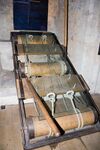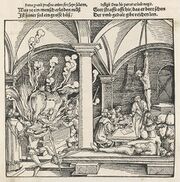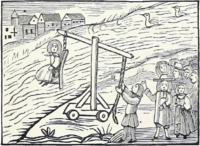List of methods of torture
Topic: Engineering
 From HandWiki - Reading time: 9 min
From HandWiki - Reading time: 9 min
A list of torture methods and devices includes:
Psychological torture methods
- Ego-Fragmentation
- Learned Helplessness
- Chinese water torture
- Welcome parade (torture)
- White room torture[1]
Physical torture methods
Instruments of torture
Note that the line between "torture method" and "torture device" is often blurred, particularly when a specifically named implement is but one component of a method. Also, many devices that can be used for torture have mainstream uses, completely unrelated to torture.
Medieval and early modern instruments of torture
Chair of Torture
Appearance
There are many variants of the chair, though they all have one thing in common: spikes cover the back, arm-rests, seat, leg-rests, and foot-rests. The number of spikes in one of these chairs ranges from 500 to 1,500.
Use
To avoid movement, the victim's wrists were tied to the chair or, in one version, two bars pushed the arms against arm-rests for the spikes to penetrate the flesh even further. In some versions, there were holes under the chair's bottom where the torturer placed coal to cause severe burns while the victim still remained conscious. In other versions, there were weights that would be placed on the victim's thighs or feet. In a special version, there were spikes on the headrest, and the executioner pushed his head against it.
This instrument's strength lies primarily in the psychological fear caused to the victims. They would often use the victim's fear to coerce them into confessing by forcing the victim to watch someone else be tortured with this instrument.
The time of death greatly varied ranging from a few hours to a day or more. No spikes penetrated any vital organ, and the wounds were closed by the spikes themselves which delayed blood loss greatly.
The Rack
Origins
The rack was first used in antiquity and it is unclear exactly from which civilization it originated, though some of the earliest examples are from Greece.
Arrian's Anabasis of Alexander states that Alexander the Great had the pages who conspired in his assassination, and their mentor, his court historian Callisthenes, tortured on the rack in 328 BC.[5]
Appearance
The rack is a torture device that consists of an oblong, rectangular, usually wooden frame, slightly raised from the ground, with a roller at one, or both, ends, having at one end a fixed bar to which the legs were fastened, and at the other a movable bar to which the hands were tied. The victim's feet are fastened to one roller, and the wrists are chained to the other.
Use
The torturer turned the handle, causing the ropes to pull the victim's arms. Eventually, the victim's bones were dislocated with a loud crack, caused by snapping cartilage, ligaments or bones. If the torturer kept turning the handles, the limbs would eventually be torn off.
This method was mostly used to extract confessions, not confessing meant that the torturer could stretch more. Sometimes, torturers forced their victim to watch other people be tortured with this device to implant psychological fear.
Many knights from the Knights Templar were tortured with the rack. The limbs collected from this and other punishments of the time were "emptied by the hundreds".
Sometimes, this method was limited to dislocating a few bones, but the torturer often went too far and rendered the legs or arms (sometimes both) useless. In the late Middle Ages, some new variants of this instrument appeared. They often had spikes that penetrated the victim's back - as the limbs were pulled apart, so was his or her spinal cord increasing not only in physical pain but the psychological one of being handicapped at best, too.
Brazen Bull
Origins
The Brazen Bull was invented in Ancient Greece , by Perillos of Athens. Perillos proposed his idea of a more painful means of execution to Phalaris, the tyrant of Akraga. Phalaris liked the idea of the Brazen Bull, and so it was made. Once finished, Phalaris ordered it to be tested on Perillos himself. Perillos was removed from the Bull before he died, but was later killed by Phalaris when he threw Perillos off a hill.[citation needed] The Greek had specially engineered tubes to make the screams of the victims sound like the noise of a bull.
Appearance
The Bull was made wholly of brass, and was hollow with a door in the side.
Use
When a victim was placed inside the brazen bull, they were slowly burned to death. The device gradually became more sophisticated, until the Greeks invented a complex system of tubes in order to make the victim's screams sound more like an infuriated bull, and also made it so the smoke from it rose in clouds of incense. This torture is similar to being boiled alive.
Even though this torture was not used during the Middle Ages as it was used earlier by the Greek and Romans, a simple form of boiling was still used in Central Europe, without the use of the bull.
Chinese Iron Maiden
Origin
Similar to the Iron Maiden of the 19th century, this device was first used in the Ming Dynasty.
Appearance
It stood like a coffin but was raised on a platform with an iron grate on the bottom instead of a piece of wood. Like the Iron Maiden, this coffin was made of brass or sometimes even iron. But, unlike the iron maiden, it was optional to include spikes or not.
Use
The Chinese Iron Maiden was generally used to punish those who were not loyal to the king but it was also used to set an example for other future wrongdoers. The prisoner would be locked into the coffin and made to stand on the grated bottom. Then, the executioner would pour water onto hot coals that they placed under the grated platform. The mixture of hot coals and cold water would create a cloud of steam that went into the coffin, steaming the person alive.
Pear of Anguish
Appearance
A pear shaped instrument, consisting of four leaves that slowly separated from each other as the torturer turned the screw at the top.
Use
There is no contemporary first-hand account of those devices or their use. An early mention of a spring-loaded gagging device is in F. de Calvi's L'Inventaire général de l'histoire des larrons ("General inventory of the history of thieves"), written in 1639, which attributes the invention to a robber named Capitaine Gaucherou de Palioly in the days of Henry of Navarre.
Further mentions of the device appear in the 19th century. They are also mentioned in Grose's Dictionary of the Vulgar Tongue (1811) as "Choak Pears," and described as being "formerly used in Holland."[3]
They were also discussed in a book by Eldridge and Watts, superintendent of police and chief inspector of the detective bureau in Boston, Massachusetts (1897). While accepting that ordinary pear-shaped gags exist, they observed that contemporary robbers used no such device as Palioly's Pear and cast doubt upon its very existence in the first place, saying that "fortunately for us this 'diabolical invention' appears to be one of the lost arts, if, indeed, it ever existed outside of de Calvi's head. There is no doubt, however, of the fashioning of a pear-shaped gag which has been largely used in former days by robbers in Europe, and may still be employed to some extent. This is also known as the 'choke-pear', though it is far less marvellous and dangerous than the pear of Palioly."
Though there is little or no evidence of its being used by bandits, there are a number of examples of ornate and elaborate, pear-shaped devices with three or four leaves or lobes, driven by turning a key that rotates the central screw thread, which spreads the leaves. These are generally held in museums devoted to the subject of torture, and are described as instruments of torture by distension or evisceration. Some, but not all, have small spikes of uncertain purpose at the bottom of each leaf. However, these devices do not seem to match the descriptions given by Calvi or the 19th century sources.
Dunking
Use This was a form of punishment that was mainly reserved for supposed witches. The victim was tied to a chair which was elevated by ropes above a pond or Barrel/vat of water. The victim was then lowered into the water until completely Underwater|submerged. The chair was raised if the victim was about to pass out or to give the victim a chance to Confession (law)|confess. Often, some form of a plug, or more simply, a piece of fruit, was placed in the victim's mouth and nose beforehand, so they couldn't get a good breath before being dunked. If the victim confessed they would most likely be killed. This method was widely used during the Spanish Inquisition and in England and France. The victim was usually intermittently submerged for many hours until he or she revealed information or death had occurred. Ordeal by water began with the witch-hunts of the 16th and 17th centuries. King James VI of Scotland (later also James I of England) claimed in his Daemonologie that water was so pure an element that it repelled the guilty.
While supposed witches were commonly tortured using this method, thieves and murderers could be subjected to it in order to extract a confession. This was more common when other more sophisticated torture devices were not present. It might not sound that bad, but you cannot control how long you are underwater.
Dunking was also used as punishment for common scolds.
Boiling
Use
In England, statute 22 passed in 1532 by Henry VIII, made boiling a legal form of capital punishment. It began to be used for murderers who used poisons after the Bishop of Rochester's cook, Richard Rice, gave a number of people poisoned porridge, resulting in two deaths in February 1532.[6] Boiling to death was employed again in 1542 for a woman who also used poison.[7][8] It was also used for counterfeiters, swindlers and coin forgers during the Middle Ages.[9]
A large cauldron was filled with water, oil, tar, tallow or molten lead. The liquid was then boiled. Sometimes the victim would be placed in the cauldron before it was boiled so as to be cooked slowly. Or they would be placed, usually head first, into the already boiling liquid.
This was more frequently a way to execute a prisoner rather than to extract a confession.
Exposure
Types
Freezing to death
In the winter, the naked victim was forced to stand outside in full view of everyone. Slowly, the torturer poured water on the victim's head which eventually became frozen, making them die slowly and painfully. Sometimes the body was left for the whole winter to terrify the population and dissuade any further crimes. [citation needed]
Burning
In the summer, the person would be coated with a mixture of boiling water and oil while stripped naked and put out in the sun. Which would cause them to burn to death. [citation needed]
Live Burial
As its name implies, this method consists of exposing a victim to the elements. The victim could be buried up to their neck letting any animals, insects or other people kill them slowly. [citation needed]
Restraint
In some towns there were chains, stocks or ropes used to quickly restrain someone outside. [citation needed] In very severe cases, the victim was simply left to die of hunger and thirst. [citation needed]
In addition to regular restraint, the gibbet, a large basket made of iron or other metal, with holes large enough for arms and legs, but not for an entire body to fit through, would be hung from a pole with a person inside it. During hot days, the metal would heat, causing pain. During cold days and nights, the chill, as well as lack of protection from the wind, could easily sap a victim's body heat. The holes in the grating were also big enough to allow carrion birds, and the occasional rat, to enter and pluck at a victim's skin and eyes. [citation needed]
Use
Due to its cost efficiency and cruelty, exposure torture was very widespread in medieval Europe. The victim's remains often served as a warning to the population. [citation needed]
In many cases, the victim was sentenced to a short period of exposure, depending on the crime. [citation needed] However, death was frequent since they were completely defenseless. [citation needed]
Brown Rats/ Tickle torture
A cheap and effective way to torture someone was with the use of rats. There were many variants, but the most common was to force a rat through a victim's body (usually the intestines) as a way to escape. The victim would be completely restrained and tied to the ground or a bed, and the torturer would cut slits into the victim's stomach. The torturer would then use a bowl to trap rats on the victim's stomach, then place hot coal on top of the bowl; the rats would then get hot, and after a few seconds would enter the victim's stomach. Gnawing the intestines usually resulted in a few hours of pain for the victim. This almost always resulted in death.
See also
- List of methods of capital punishment (torture devices)
- Peine forte et dure
- Torture chamber
- Torture Museums
- Rüdesheim am Rhein#Museums (Mediaeval Torture Museum)
- Turcas
References
- ↑ "'White Torture' Is A Sensory Deprivation Method That Erases All Sense Of Reality" (in en). https://www.ranker.com/list/extreme-white-torture-facts/jodi-smith.
- ↑ "'It Was Torture': An Abu Ghraib Interrogator Acknowledges 'Horrible Mistakes'". NPR, National Public Radio, US. National Public Radio. Apr 4, 2016. https://www.npr.org/sections/parallels/2016/04/04/472964974/it-was-torture-an-abu-ghraib-interrogator-acknowledges-horrible-mistakes.
- ↑ "Ex-Abu Ghraib Interrogator: Israelis Trained U.S. to Use "Palestinian Chair" Torture Device". Democracy Now!. Democracy Now!. Apr 7, 2016. https://www.democracynow.org/2016/4/7/ex_abu_ghraib_interrogator_israelis_trained.
- ↑ R.D. Melville (1905), "The Use and Forms of Judicial Torture in England and Scotland," The Scottish Historical Review, vol. 2, p. 228; Geoffrey Abbott (2006) Execution: the guillotine, the Pendulum, the Thousand Cuts, the Spanish Donkey, and 66 Other Ways of Putting Someone to Death, MacMillan, ISBN:0-312-35222-0, p. 213. Both of these refer to the use of the pendulum (pendola) by inquisitorial tribunals. Melville, however, refers only to its use as a torture method, while Abbott suggests that the device was purposely allowed to kill the victim if he refused to confess.
- ↑ The Anabasis of Arrian
- ↑ Kesselring, K. J. (1 September 2001). "A Draft of the 1531 'Acte for Poysoning'". The English Historical Review CXVI (468): 894–899. doi:10.1093/ehr/CXVI.468.894.
- ↑ Newlin, George (2000), Understanding Great expectations, Westport, Conn.: Greenwood Press, pp. 136, ISBN 978-0-313-29940-7, OCLC 41488673, https://archive.org/details/understandinggre00newl/page/136
- ↑ Leslie, Frank, Frank Leslie, and Ellery Sedgwick. 1876. Frank Leslie's popular monthly. [New York]: Frank Leslie Pub. House. p 343
- ↑ Monter, E. William (2007). A bewitched duchy: Lorraine and its dukes, 1477-1736. Librairie Droz. p. 163. ISBN 978-2-600-01165-5.
9 views | Status: cached on August 01 2024 06:52:28
↧ Download this article as ZWI file
 KSF
KSF


